Labrang Monastery (拉卜楞寺, Labrang Temple, Labuleng Monastery), located in Xiahe County, Gansu Province, China, was founded by the First Jamyang Zhepa, Ngawang Tsöndrü, in 1709 during the 48th year of Emperor Kangxi’s reign in the Qing Dynasty. The full Tibetan name of the monastery is “Ganden Shadrupling,” which translates to “the place of auspiciousness and happiness.” It is commonly referred to as Labrang Monastery, derived from the Tibetan term “Labrang,” meaning the residence of a high lama or living Buddha. Labrang Monastery is one of the six great monasteries of the Gelug (Yellow Hat) school of Tibetan Buddhism and retains one of the best Tibetan Buddhist teaching systems in China. At its peak, the monastery housed over 4,000 monks and was considered the political and religious center of the Gannan region, with 108 subsidiary monasteries under its jurisdiction (although the actual number is much higher).
The monastery’s architecture predominantly utilizes local materials such as stone, wood, earth, and hemp, with minimal use of metals. The buildings are designed with a wide base and narrow top, resembling a trapezoidal shape. The exterior stone structures are complemented by wooden interiors, adhering to the saying, “no wood seen outside, no stone seen inside.” The buildings are painted with red, yellow, and white earth pigments according to their function and status. Colorful cloth drapes adorn the balconies and eaves, and larger structures feature golden wheels of Dharma, mythical creatures, treasure vases, banners, gilded roofs, and bronze finials. Some of the larger halls also incorporate Han Chinese architectural elements, with palace-style roofs covered in gilded bronze tiles or green glazed tiles.
Labrang Monastery houses over 10,000 pieces of ethnic and Buddhist art and artifacts. The monastery boasts sixteen large statues of Buddhas made of gilded copper or carved sandalwood, each over eight meters tall. Numerous smaller statues of Buddhas, Bodhisattvas, stupas, and ritual objects of various materials are also present. The monastery preserves the personal belongings and clothing of successive Jamyang Zhepas, as well as imperial edicts, seals, and large plaques conferred by Chinese emperors. Among the treasures are a thousand-Buddha tree, pearl stupa, jade ruyi scepters, meteorites, and sea mammal teeth.
Labrang Monastery, renowned for its vast prayer wheel corridor with over 2,000 prayer wheels, offers a unique pilgrimage experience where it takes at least an hour to complete all these wheels. At the southwest corner stands an ancient wooden bridge spanning the Xiahe River, leading up to a panoramic view from the Sunning Buddha Terrace, capturing the essence of Labrang Monastery. Visitors typically follow a clockwise path around the monastery, a ritual reflecting Tibetan Buddhist pilgrimage traditions.
Table of Contents
- Basic Information
- Location and Transportation
- Highlights of Labrang Monastery
- Historic Treasures in Labrang Monastery
- Festivals and Temple Affairs in Labrang Monastery
- Vlog of Labrang Monastery
- History of Labrang Monastery
- Other Attractions in Xiahe County
Basic Information
| Estimated Length of Tour | 3 hours |
| Ticket Price | 45 RMB |
| Opening Hours | 8.00 – 18.00 (1st May – 7th October) 9.15 – 16.30 (8th October – 30th April) |
| Best Time to Visit | Four seasons |
| Establishment Time | 1709 |
| Telephone Number | 0086-0941-7182666 0086-0941-7121095 |
Location and Transportation
Labrang Monastery is located 0.5 kilometers west of Xiahe County in Gannan Tibetan Autonomous Prefecture, Gansu Province. It covers a total area of 866,000 square meters with over 400,000 square meters of built-up area, including more than 90 main halls. To reach Labrang, you can take a bus from Lanzhou Bus South Station to Xiahe, a journey of about 4 hours with a ticket price around 75 yuan.
Highlights of Labrang Monastery
Grand Sutra Hall (大经堂)

Labrang Monastery is renowned for its grand assembly halls, among which the largest and most significant is the Grand Sutra Hall (闻思学院经堂), also known as the Grand Hall of Exoteric Teachings. This hall serves as the central hub for the monastery and the site for the “Chojin Chodwa” meetings.
Originally built by the First Jamyang Zhepa with only 80 pillars, the Grand Sutra Hall was expanded in 1772 by the Second Jamyang Zhepa to accommodate 140 pillars, allowing space for up to 3,000 monks to chant sutras. In 1946, the Fifth Jamyang Zhepa added a front courtyard, resulting in the most magnificent structure within the monastery, encompassing the front hall, front courtyard, main hall, and rear hall, with several hundred rooms spread over more than ten acres.
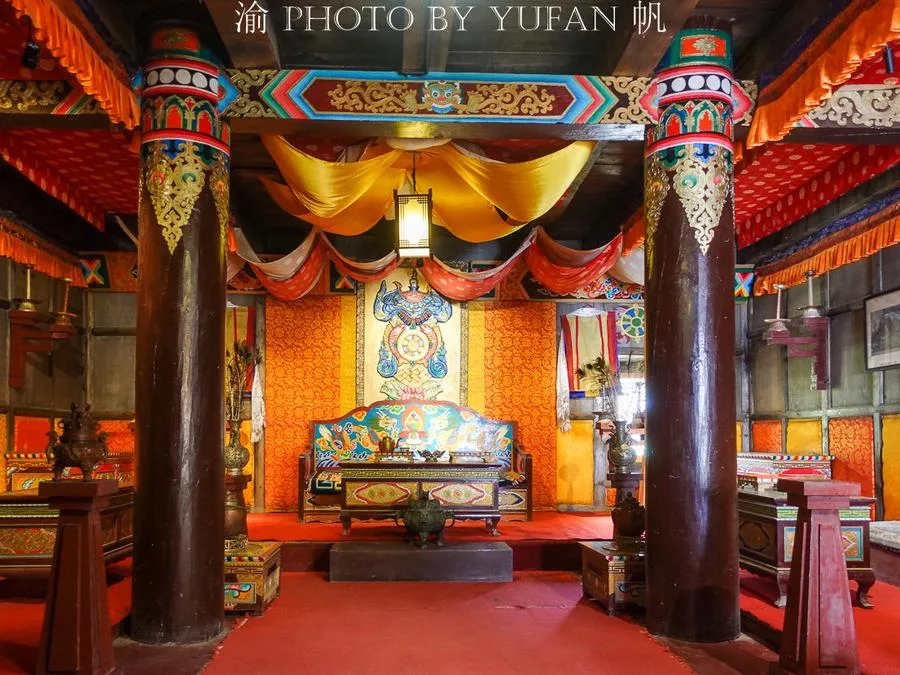
The front hall is a large rooftop structure adorned with decorative elements like treasure vases and Dharma wheels. Upstairs, statues of the Tibetan king Songtsen Gampo are enshrined. The front balcony provides seats for the Jamyang Zhepas, the four senior monks (Sachu), and the eight great khenpos (Khenpo) during the major ceremonies held in January and July each year. The lower front balcony houses the seats for the monastery’s administrative monks during these events. The front courtyard is the venue for the monks’ debates and examinations for academic degrees, featuring 32 rooms along the corridors.
The main hall of the Grand Sutra Hall measures 14 rooms wide from east to west and 11 rooms deep from north to south. The interior is resplendent with a plaque inscribed by Emperor Qianlong, which reads “Hui Jue Si” (慧觉寺), meaning “Temple of Wisdom and Enlightenment.” The hall is equipped with seats for the Jamyang Zhepas, the chief Dharma teacher, and the monks’ chanting mats. It houses statues of Shakyamuni Buddha, Tsongkhapa, the Sixteen Arhats, and successive Jamyang Zhepas, along with exquisite embroidered thangkas and banners. The hall also contains precious Buddhist scriptures, including the Kangyur.

The rear hall’s centerpiece is a large gilded bronze statue of Maitreya Buddha. To the left are the stupa relics of the successive Jamyang Zhepas, as well as the stupa relics of the Mongolian and Henan princes and other eminent lamas, totaling 14 stupas. The right side of the rear hall is dedicated to the monastery’s protector deities. Adjacent to the main hall, to the west, is the large kitchen equipped with four large copper cauldrons and one iron cauldron.
Tragically, the Grand Sutra Hall was destroyed by fire on April 7, 1985. Reconstruction began in July 1985, with groundbreaking in June 1986, and the main structure completed in 1987. The new Grand Sutra Hall retains the original design and style while incorporating advanced techniques and materials.
Other Assembly Halls

Labrang Monastery is home to several notable assembly halls, each with its own unique history and significance. Besides the Grand Sutra Hall, the monastery includes the halls of the Kalachakra Institute, Medical Institute, and the Upper and Lower Tantric Institutes, each contributing to the rich religious and educational fabric of the monastery.
Kalachakra Institute Hall (时轮学院经堂) Built in 1763, the Kalachakra Institute Hall is located to the right of the Grand Sutra Hall. It features a strong Tibetan architectural style, with the main hall measuring five rooms from east to west and eleven rooms from north to south. Inside, it houses a bronze statue of Kalachakra Buddha. The rear hall is centered around statues of Shakyamuni Buddha and his seven main disciples, flanked by stupas of important lamas such as Khenpo Khangsar, Gontang Lobsang, and Danba Gyatso.
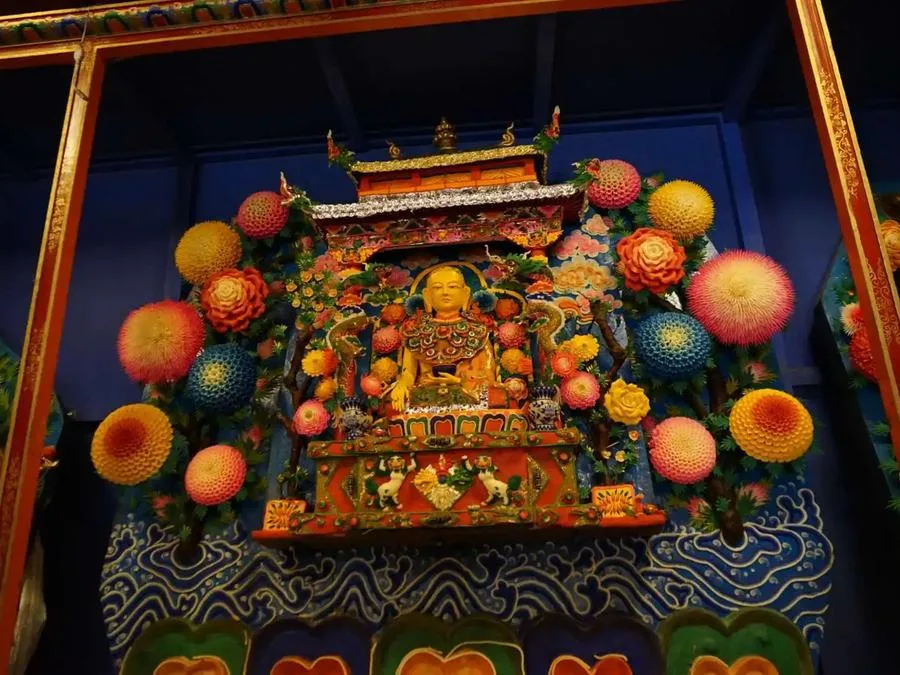
Medical Institute Hall (医学院经堂) Established in 1784, the Medical Institute Hall’s main hall spans six rooms from north to south and five rooms from east to west. The hall is dedicated to the Medicine Buddha and Yao Wang Buddha, with a stupa containing the relics of the lama Lhakor Khangsar. The front corridor is adorned with 18 murals depicting human anatomical charts, reflecting the hall’s medical focus.
Vajra Institute Hall (喜金刚学院经堂) Constructed in 1879, the Vajra Institute Hall was modeled after the Namgyal Institute in Lhasa’s Potala Palace. It was destroyed by fire in 1957 but later reconstructed with state funding to its original design. This hall is dedicated to the teachings and practices of Vajrayana Buddhism, housing various sacred artifacts and statues.

Upper Tantric Institute Hall (续部上学院经堂) Located to the west of the Vajra Institute, the Upper Tantric Institute Hall was built in 1941. Its main hall spans five rooms from east to west and ten rooms from north to south, rising to three stories. The top floor features a palace-style roof covered in green glazed tiles, earning it the name “Green Tile Temple.” The rear hall contains a bronze statue of Maitreya Buddha and the Sixteen Arhats, with the left side dedicated to the Eight Medicine Buddhas and 35 Confession Buddhas. The right side houses the ashes of the fifth Jamyang Zhepa’s parents and 21 statues of Tara. The hall also boasts 1,000 bronze statues of Amitayus Buddha.
Lower Tantric Institute Hall (续部下院经堂) Positioned northeast of the Grand Sutra Hall, the Lower Tantric Institute Hall was initially built in 1737. The main hall measures five rooms from east to west and one room from north to south, exemplifying traditional Tibetan architecture with features like Dharma wheels and banners on the roof. Inside, it houses statues of deities such as Guhyasamaja, Yamantaka, and Chakrasamvara. The rear hall is dedicated to the stupas of seven notable lamas, including the first Deva Khangsar.
Gongtang Pagoda (贡唐宝塔)
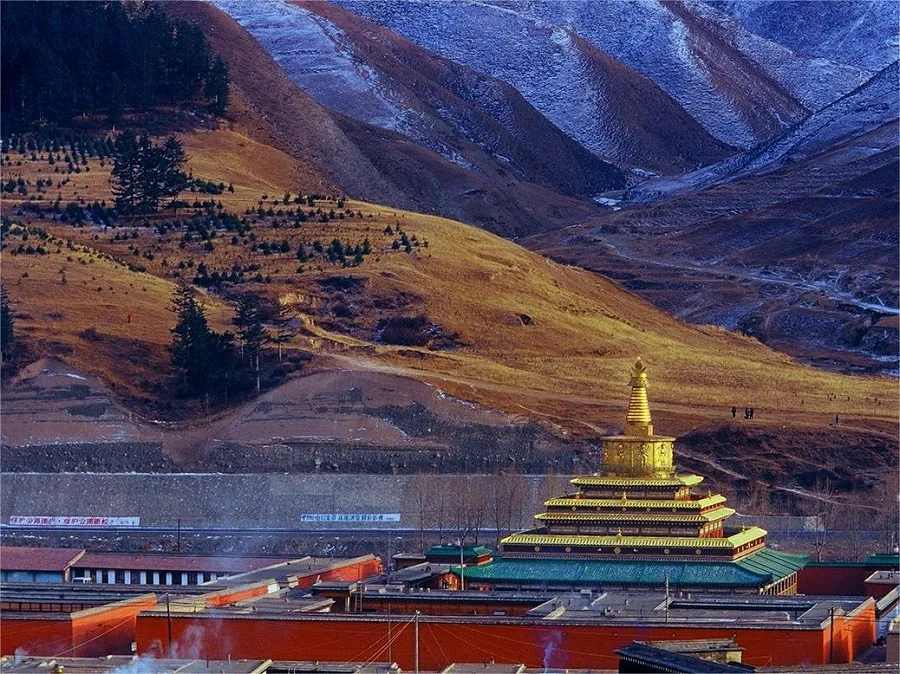
Gongtang Pagoda, originally named the Great Gold Pagoda of Instant Liberation, is renowned both domestically and internationally for housing a statue of Amitabha Buddha brought from Nepal. The pagoda was initially constructed in 1805 by the esteemed scholar of Labrang Monastery, the Third Gongtang Tsang, Gongque Danbei Zhongmei. In 1806, the Qing Emperor Jiaqing bestowed upon it a plaque inscribed with “佛光普照 (Buddha’s Light Shines Everywhere).” Subsequent renovations by the Fourth and Fifth Gongtang Tsang masters involved significant investment, elevating the pagoda to an unparalleled level of architectural and religious significance. Unfortunately, the pagoda suffered destruction during the Cultural Revolution.
In 1980, after Labrang Monastery reopened to the public, the Sixth Gongtang Tsang, Danbei Wangxu, endeavored to restore the pagoda. With the support of the government, overseas Chinese, and devout followers, reconstruction began on February 8, 1991, following a purification ritual. After two and a half years, the newly rebuilt Gongtang Pagoda was consecrated on July 1993, coinciding with the auspicious festival commemorating Buddha Shakyamuni’s first teaching.

The reconstructed Gongtang Pagoda, built on its original site at the southwest corner of Labrang Monastery, stands five stories tall and comprises three main sections: the spire, the pagoda body, and the base. The spire features radiant representations of the sun, moon, and stars. The pagoda body showcases gilded copper reliefs of the eight great Bodhisattvas. The base, adorned with glazed tiles, is a three-tiered, four-cornered structure with copper prayer wheels around the first level. The pagoda’s majestic exterior is matched by its intricately decorated interior.
The central part of the pagoda houses four interconnected Buddha halls spanning two levels. The front hall contains the inner pagoda, holding the relics of the Third Gongtang Tsang, along with gilded statues of the First, Second, Fourth, and Fifth Gongtang Tsang masters. The side halls are dedicated to Tara and Samantabhadra, while the rear hall serves as a scripture hall containing over 20,000 Buddhist texts. The ceiling above these halls is adorned with over 300 bronze statues encircling a statue of the Second Jamyang, emphasizing the sacred atmosphere.
On the third floor, the Thousand Buddha Hall enshrines 1,032 bronze Buddha statues. The fourth floor features a nearly two-meter-tall statue of Amitabha Buddha within the central chamber. The walls of the pagoda’s base and the inner chambers are adorned with over a hundred finely detailed murals depicting various Buddhist narratives.
Maitreya Hall (弥勒佛殿)
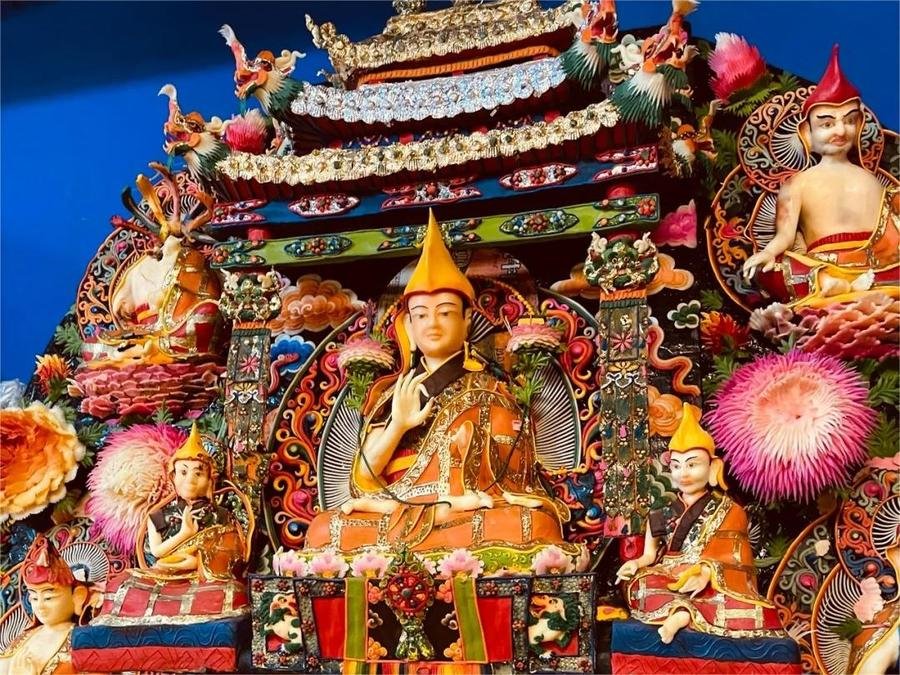
The Maitreya Hall, also known as the “Shou Cao Temple (寿槽寺),” is situated in the northwest corner of the Grand Sutra Hall. This towering six-story structure, measuring five rooms deep on each side, was originally built in 1788. In 1844, it was renovated and expanded with funds donated by the eminent scholar Eerdini Banzhida from Zhuoni. The hall features a mixed Tibetan-Chinese architectural style, with its top floor designed as a palace-style square pavilion adorned with gilded bronze lions, dragons, vases, Dharma wheels, and Ruyi scepters, making it a dazzling sight under the sunlight. This building is commonly referred to as the “Great Golden Roof Temple” due to its opulent appearance. Inside, it houses a magnificent eight-meter-tall gilded bronze statue of Maitreya Buddha. Flanking this statue are eight five-meter-tall gilded bronze statues of Bodhisattvas. The hall also preserves sacred texts, including copies of the Kangyur written in gold and silver ink.
Shakyamuni Hall (释迦牟尼殿)

The Shakyamuni Hall, located to the west of the Maitreya Hall, is modeled after the Jokhang Temple in Lhasa. This hall also features a gilded bronze roof, earning it the nickname “Little Golden Roof Temple.” The hall stands three stories high. The second floor enshrines a statue of Shakyamuni Buddha, accompanied by two bronze dragon columns. Above the statue, there is a smaller, 0.7-meter-high gold statue of Shakyamuni Buddha, brought from Tibet’s Bontoe area by the first Jamyang Zhepa, making it a precious relic. The third floor houses the protector deity chapel of the Jamyang Zhepas, while the front of the hall, known as Tudan Phodrang, serves as the ceremonial site for the enthronement and other significant rituals of the Jamyang Zhepas.
The Shou’an Hall (Longevity and Peace Hall), funded by Samutse Zhuang, is located in front of the Kalachakra Institute. This hall measures five rooms deep on each side and features a plaque inscribed with “寿安寺 (Shou’an Temple)” in four languages: Chinese, Tibetan, Manchu, and Mongolian, bestowed by Emperor Jiaqing of the Qing Dynasty. Inside, it houses a 13-meter-tall bronze statue of the “Lion’s Roar Buddha,” along with statues of the Eight Great Bodhisattvas and the Sixteen Arhats.
Other Magnificent Buildings

Sutra Library: The Sutra Library is located to the west of the Samutse Zhuang Hall and houses over 60,000 volumes of scriptures. Unfortunately, during the Cultural Revolution, the library suffered significant damage, and many scriptures were relocated to the Kalachakra Institute. The library has since been rebuilt and continues to serve as a repository for important religious texts.
Printing House: The Printing House is situated in front of the Thousand-Armed and Thousand-Eyed Avalokiteshvara Hall. Originally belonging to the Mongolian Henan Prince’s mansion, it holds a vast collection of scripture blocks. Although it was also damaged during the Cultural Revolution, it has been restored and expanded. The Printing House now includes modern printing equipment, such as bronze type molds, typecasting machines, and platform printing machines.
Shadan Lhakhang: The Shadan Lhakhang, located northeast of the Grand Sutra Hall, serves as the palace for the Panchen Lama. This building is an important part of the monastery’s history and religious practices.

Bodhi Dharma Courtyard: The Bodhi Dharma Courtyard is the debate yard for monks and is located south of the Sahar Village on the western side of the monastery. It is where monks engage in traditional Buddhist debate, an essential practice in their education and spiritual development.
Copper Stupa: The Copper Stupa, a three-story gilded structure, is highly treasured and located within the Gontang Zhuang Institute, also known as the Gontang Stupa. Another notable stupa is the Helit Tower situated to the east of the Grand Sutra Hall, and the “Divine White Stupa” located on the eastern side of the monastery.
Auxiliary Buildings: Other notable buildings include the kitchen and a pavilion. The monastery also had a grand archway on the eastern side, which featured a plaque inscribed with “Defend the Nation with Wealth.” However, this archway no longer exists.
Historic Treasures in Labrang Monastery
Buddhist Statues
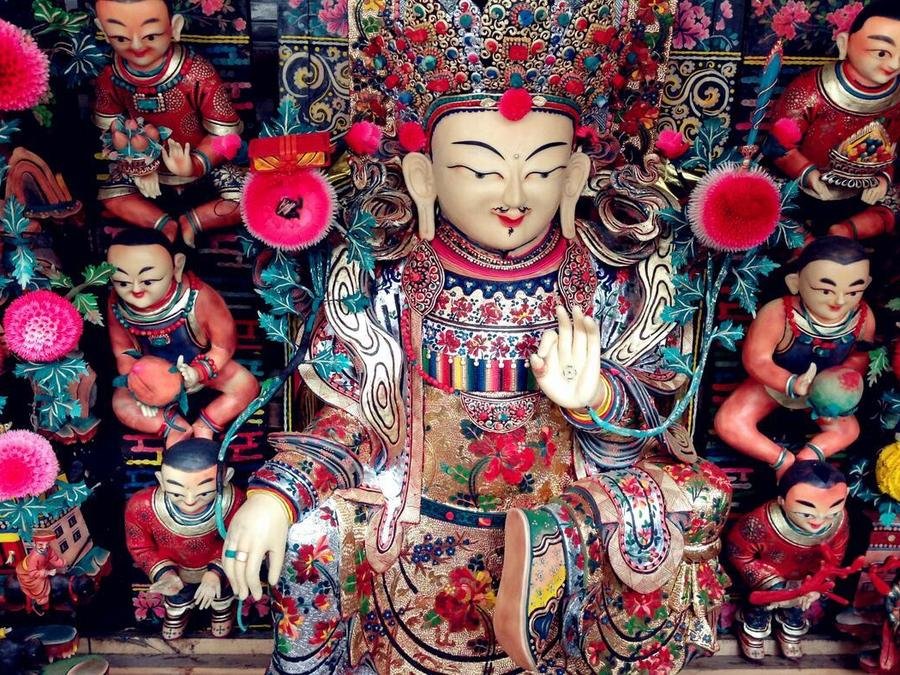
Labrang Monastery houses an impressive array of Buddhist statues that vary in size, material, and craftsmanship. The statues range from towering figures up to 20 meters tall to small statuettes less than an inch high. The materials used for these statues include gold, silver, purple copper, yellow brass, pure gold, ivory, coral, agate, crystal, jade, sandalwood, ceramics, vitreous enamel, and medicinal clay.
Among the significant statues, there are 16 that exceed 8 meters in height, with the tallest reaching up to 18 meters. These statues were crafted by master artisans from various regions including India, Bangladesh, Nepal, Iran, Tibet, Qinghai, Mongolia, and Beijing. The artistry involved in creating these statues is exceptional, with the figures exuding a sense of solemnity and grace, adorned in shimmering gold and displaying lifelike expressions that captivate visitors.
Ancient Scriptures

The monastery’s library is a treasure trove of ancient scriptures and books, housing over 80,000 volumes. These texts cover a wide range of subjects including philosophy, esoteric Buddhism, medicine, phonetics, history, biographies, arts and crafts, astronomy, and grammar. The collection includes original works by Tsongkhapa, the founder of the Gelug school, scriptures compiled by successive Jamyang masters and high monks, and treatises by the Dalai Lama, Panchen Lama, and other prominent Tibetan Buddhist figures.
One of the most valuable texts is the “Beyul Rinpoche” written by the Indian sage Vartendra Tavajita in gold ink. Another prized item is the “Golden Garland Sutra” written by the First Jamyang Shepa in gold ink. Additionally, the library holds the “Great Treatise on the Stages of the Path to Enlightenment” by Tsongkhapa, the “Biography of Songtsen Gampo” written in silver ink, and the “Diamond Sutra” inscribed with a mixture of gold, silver, coral, malachite, pearls, and mother-of-pearl powders.

Before 1958, Labrang Monastery’s library contained over 228,000 volumes of scriptures. However, the collection suffered significant losses during the Cultural Revolution. By 2002, only 65,000 volumes remained, which accounted for 39.6% of the original collection. These remaining texts include medical books, phonetic works, craft manuals, astronomical and calendrical texts, rhetorical treatises, letters, historical documents, biographies, anthologies, and various Buddhist scriptures.
To preserve and study these invaluable texts, the Gansu Provincial Government established the “Gansu Province Labrang Monastery Library Research Institute” in 1988, which was later renamed the “Gansu Institute of Tibetan Studies.” This institute focuses on researching and protecting the literary heritage of Labrang Monastery.
Murals and Thangka Paintings
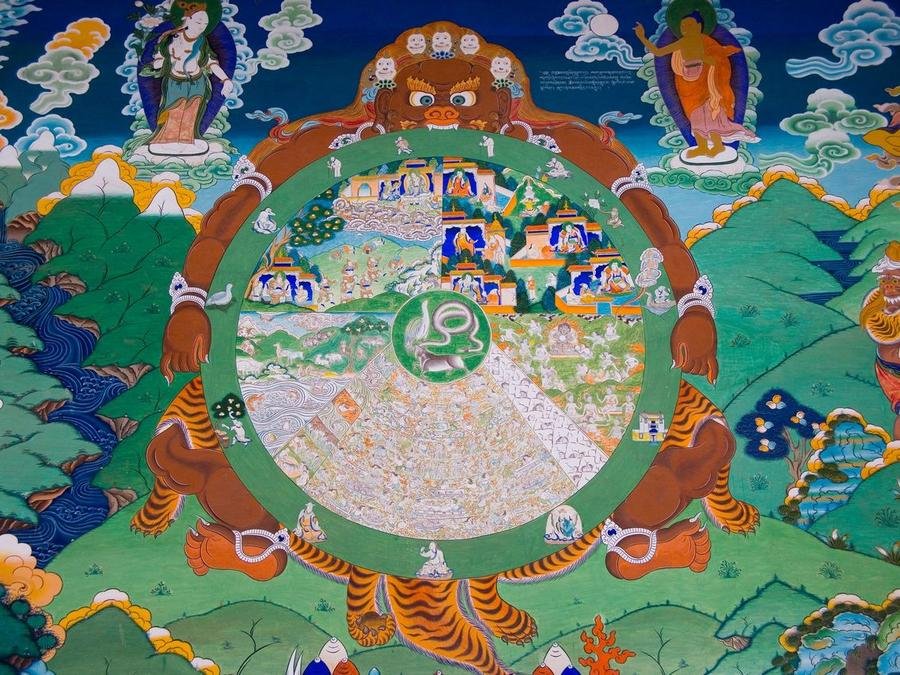
The murals in Labrang Monastery are vibrant and dynamic, depicting a wide array of subjects such as the life of the Buddha, stories from Buddhist scriptures, images of historical figures, and medical illustrations. These murals are characterized by their vivid colors and lifelike representation, bringing a sense of vitality and depth to the monastery’s walls.
Thangka paintings, or scroll paintings, are another significant artistic treasure of Labrang Monastery. These intricate works of art are painted on cloth and are highly detailed. They often depict Buddhist deities, mandalas, and religious scenes. The Thangkas are known for their exquisite craftsmanship and are considered valuable teaching tools and objects of devotion.
Appliqué Art
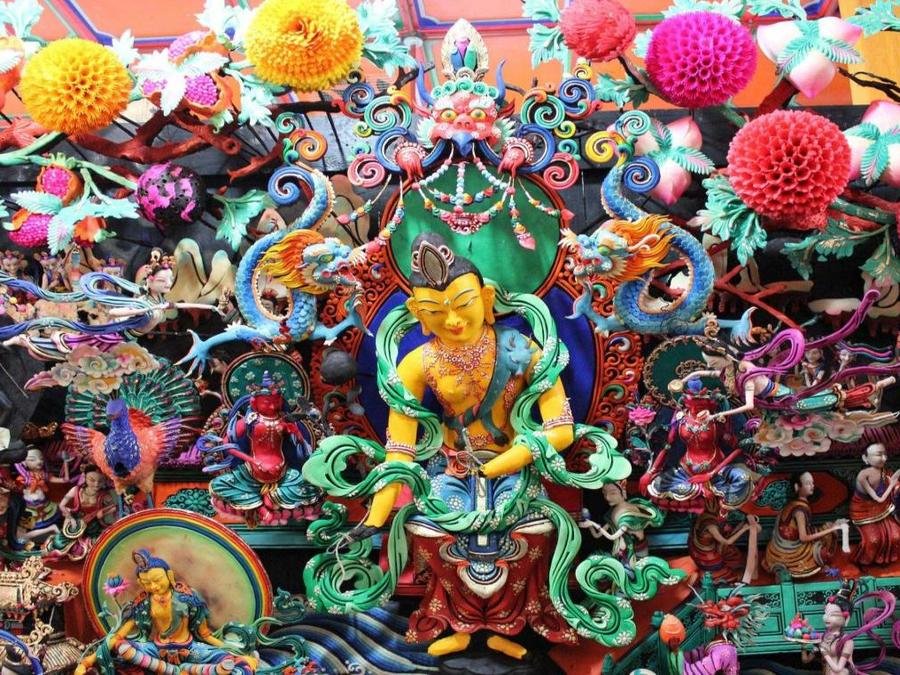
Labrang Monastery is also famous for its unique appliqué art. This involves cutting various shapes from colorful silk fabrics to create images of Buddhas, historical figures, animals, landscapes, and flowers. These shapes are then sewn onto a cloth background, with layers of wool or other materials underneath to give a three-dimensional effect. The resulting artworks are rich in color and texture, offering a striking visual experience.
Imperial Seals and Documents

Labrang Monastery also preserves several important historical documents and seals. Among these are the imperial edicts from the Guangxu Emperor of the Qing Dynasty to the Fourth Jamyang, and from the Republic of China to the Fifth Jamyang. The collection includes commendations from the Nationalist government for the Fifth Jamyang, an imperial seal bestowed by the Daoguang Emperor to the Third Jamyang, and various other seals made of gold, silver, copper, ivory, stone, and wood. In total, the monastery holds 21 seals of various sizes and materials, each of significant historical value.
Festivals and Temple Affairs in Labrang Monastery
First Month Prayer Festival (Mönlam)
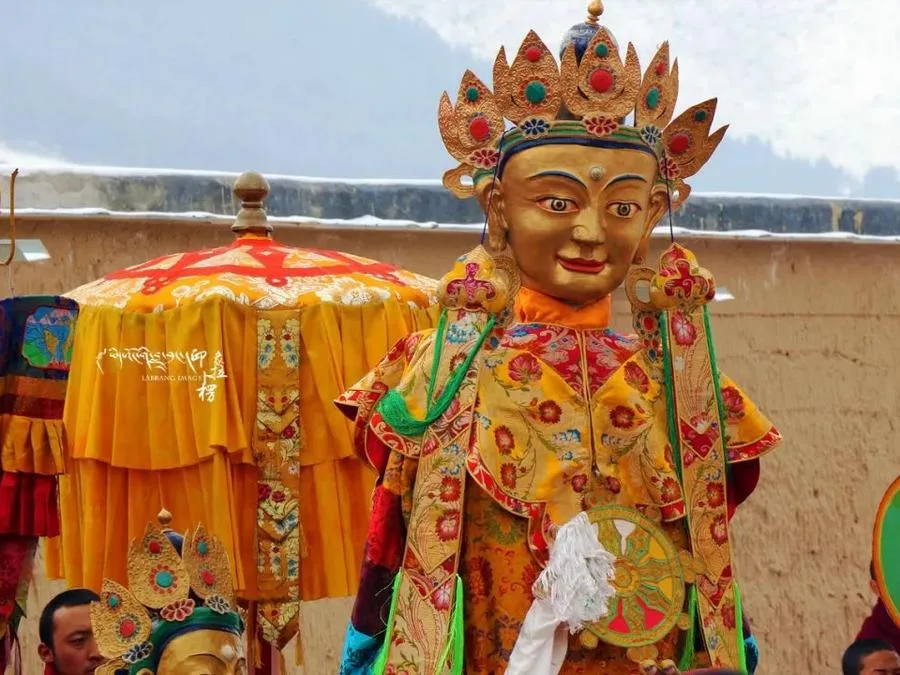
The most significant festival at Labrang Monastery is the First Month Prayer Festival, known as “Mönlam” in Tibetan. It begins on the evening of the third day of the first lunar month and lasts until the seventeenth day, spanning 15 days. During this period, all monks gather in the Grand Sutra Hall for six daily prayer sessions. The fourth session is dedicated to special prayers for the perpetuation of Buddhist teachings, the well-being of all sentient beings, and world peace.
Key Events:
- Release of Life (January 8th): Animals such as horses, cows, and sheep are symbolically freed after being blessed and adorned with colorful ribbons. These animals are then protected from hunting or slaughter.
- Unveiling of the Buddha (January 13th): A large embroidered Buddha image is displayed on the mountainside opposite the monastery, with monks chanting bathing rituals while the public watches in reverence.
- Cham Dance (January 14th): Monks perform sacred dances wearing elaborate costumes and masks, representing deities and historical figures.
- Butter Sculpture Exhibition and Lamp Offering (January 15th): Monks from various colleges create intricate butter sculptures, which are displayed around the Grand Sutra Hall and illuminated with butter lamps, creating a stunning visual spectacle. These sculptures are then judged and ranked.
- Maitreya Procession (January 16th): A statue of Maitreya, the future Buddha, is paraded around the monastery accompanied by music, symbolizing the coming of an era of future enlightenment.
The festival concludes on January 16th, with expenses shared among the 23 tribes associated with the monastery.
Second Month Dharma Assembly
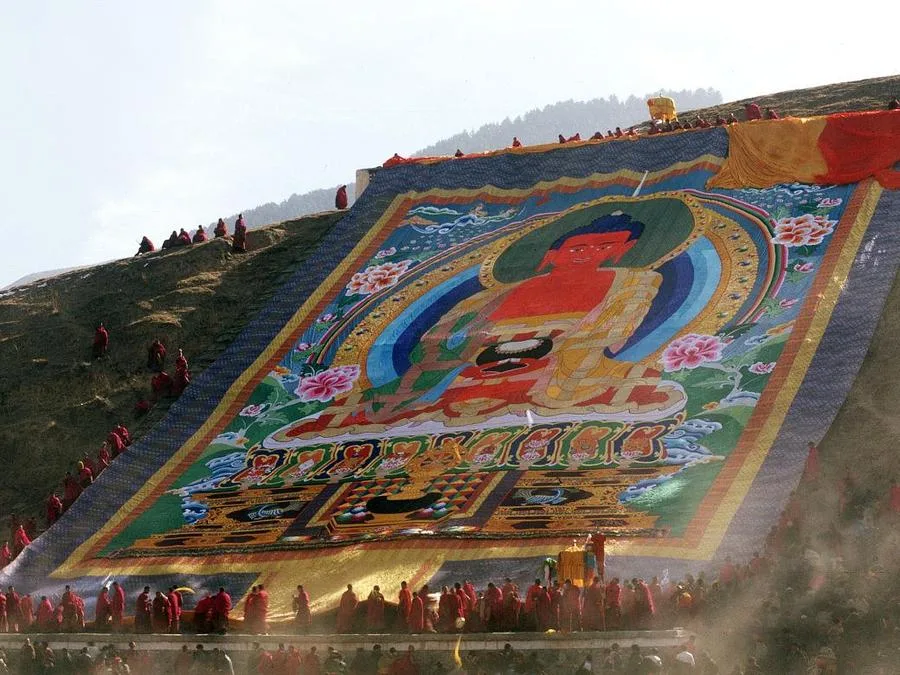
Held from the fourth to the eighth day of the second lunar month, this assembly includes the commemoration of the first Jamyang Shepa’s passing on the fifth day, known as “Good Time Day.” On the eighth day, the “Treasure Display Festival” takes place, where hundreds of monks parade around the monastery displaying valuable relics such as auspicious knots, wish-fulfilling trees, dragon eggs, a staff bestowed by Emperor Kangxi, and gold ingots.
April Saga Dawa Festival
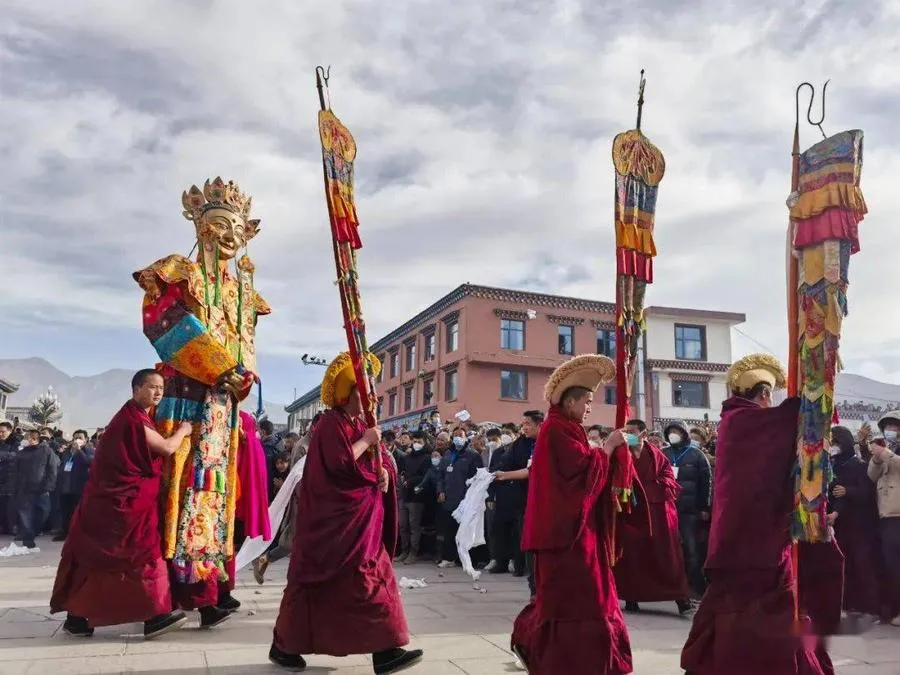
On the fifteenth day of the fourth lunar month, the Saga Dawa Festival commemorates the birth, enlightenment, and parinirvana of Shakyamuni Buddha. Monks and devotees observe a fast, spin prayer wheels, and chant the six-syllable mantra as a form of homage and spiritual practice.
Seventh Month Dharma Assembly

From the twenty-ninth day of the sixth lunar month to the fifteenth day of the seventh lunar month, the Seventh Month Dharma Assembly is the second-largest festival after the First Month Prayer Festival. The main activities include seven daily gatherings of monks for debates on Buddhist philosophy. On the eighth day, the Milarepa Dharma Assembly reenacts the story of the saint Milarepa converting the hunter Gonpo Dorje.
Ninth Month Disaster Prevention Ceremony

On the twenty-ninth day of the ninth lunar month, the Disaster Prevention Ceremony is held in the Grand Sutra Hall, organized by the Mahakala College. This ceremony aims to avert natural disasters and protect the community.
October Tsongkhapa Memorial Day

On the twenty-fifth day of the tenth lunar month, the monastery commemorates the death anniversary of Je Tsongkhapa, the founder of the Gelug school of Tibetan Buddhism. Monks chant extensive prayers, and the monastery is opened to pilgrims for veneration. In the evening, butter lamps illuminate the rooftops of the monastery, creating a mesmerizing display, hence the name “Lamp Lighting Festival.”
Additional Commemorations
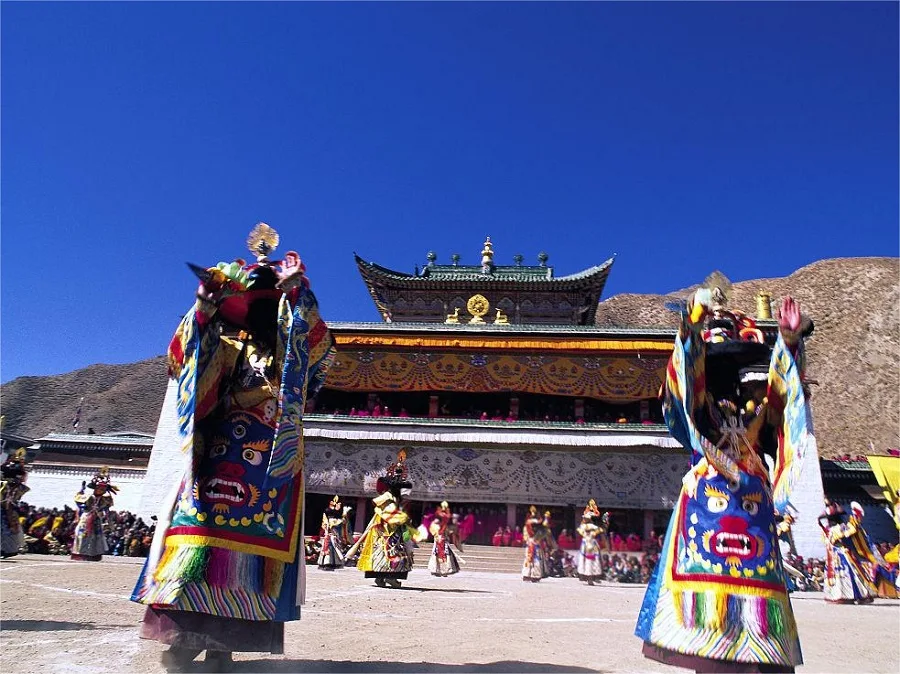
The monastery also observes memorial days for the passing of its significant figures:
- February 5th for the first Jamyang Shepa
- October 27th for the second Jamyang Shepa
- September 6th for the third Jamyang Shepa
- February 22nd for the fourth Jamyang Shepa
- February 23rd for the fifth Jamyang Shepa
On these days, special rituals and prayers are conducted to honor their memory and contributions.
Vlog of Labrang Monastery
History of Labrang Monastery
Labrang Monastery, nestled in the serene landscapes of Xiahe County, Gansu Province, holds a profound history intertwined with Tibetan Buddhism’s spread and evolution over centuries.
In the year 1709, during the reign of the Qing Emperor Kangxi, the first Jamyang Zhepa, known as Chokyi Gyeltsen, responded to an invitation from Chahan Danjin, the Prince of Qinghai Mongolia and the Chos-Khord, to return from Tibet to his ancestral homeland. Finding the picturesque valley of Sangchu River (Sangqu), he chose the auspicious site of Zaxiqiao (nowadays known as Xiahe) to establish what would become Labrang Monastery. The initial construction marked the beginning of a vast complex dedicated to Buddhist teachings and practices.
Over successive generations, under the guidance of the Jamyang Zhepa lineage and numerous prominent lamas, Labrang Monastery expanded significantly. By its zenith, it covered an area of 866,000 square meters, with over 400,000 square meters of built-up area. The monastery boasted more than 90 major halls, over 10,000 monks’ quarters, and six main colleges (dratsang), along with numerous stupas, residences for lamas, lecture halls, scripture halls, printing houses, and gardens. At its peak, it accommodated over 3,600 monks and exerted religious influence over regions spanning Gansu, Qinghai, Sichuan, Tibet, Mongolia, Northeastern China, and Xinjiang, earning it the moniker of “the second Tibet.”
Labrang Monastery not only served as a spiritual sanctuary but also emerged as a comprehensive center for Tibetan culture and arts in the Amdo region. It became renowned for its contributions to Tibetan Buddhist philosophy, medicine, astrology, and arts. The monastery’s libraries preserved vast collections of scriptures and scholarly works, attracting intellectuals and seekers of knowledge from across the Tibetan plateau.
Despite its grandeur, Labrang Monastery faced significant challenges during the 20th century. In the years leading up to the Chinese Communist Revolution in 1949, the monastery thrived as a vibrant center of learning and religious practice. However, the political upheavals that followed posed severe threats to its existence. During the “Great Leap Forward” and the “Cultural Revolution” (1966-1976), Labrang Monastery, like many religious institutions in China, suffered extensive damage and suppression. Many of its halls were repurposed into secular facilities such as factories and slaughterhouses, while precious artifacts and religious statues were destroyed or looted.
The seven-story Potala Palace-style Zangkar Lhakang Hall was demolished during the “Four Cleanups” campaign in the 1950s to build a cinema, and its magnificent 24-meter-tall Buddha statue was smashed and melted down for metal. The monastery endured years of closure, with monks dispersed and religious activities banned.
Following the reforms and opening-up policies in the late 20th century, Labrang Monastery gradually reopened its doors in 1980. The Chinese government allocated substantial funds for the restoration and preservation of the remaining structures. Significant efforts were made to repair and restore the monastery’s halls, temples, and artworks. By the present day, preservation projects have successfully restored 14 temples, including significant repairs to their original structures and frescoes covering over 6,000 square meters.

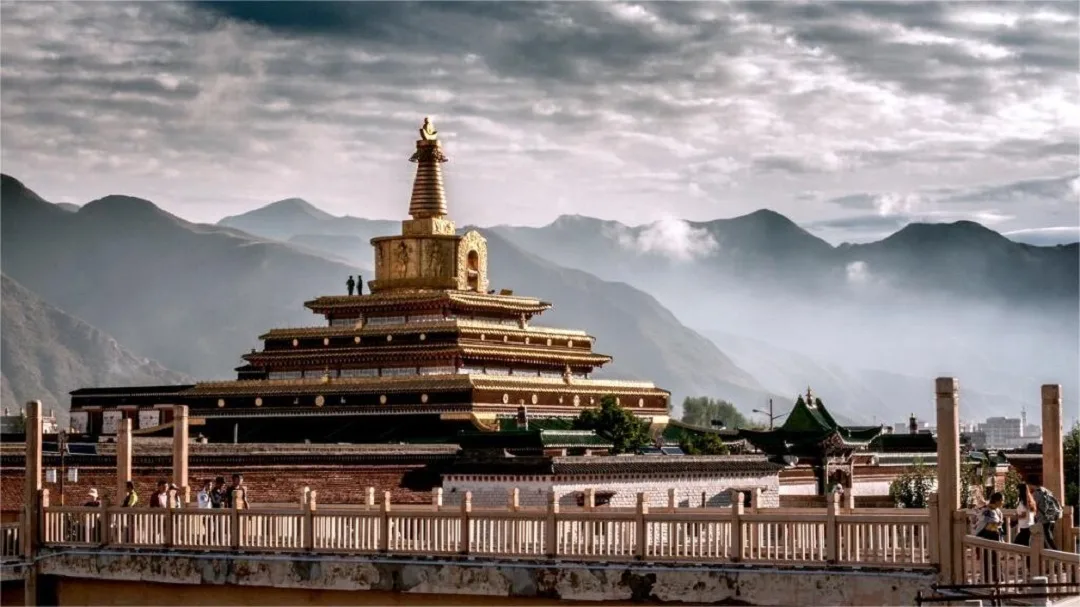




On Labuleng Temple Avenue, there are very few people. Many monks dressed in red robes walk hurriedly, and most of the faces I see are those of young people with buzzed hair and youthful expressions. The rest are worshippers, often traveling in family groups. Both men and women, young and old, are dressed neatly and respectfully, walking or waiting as they collectively make their way to the hall of faith. Tourists are extremely scarce during this season, and I feel… Read more »
Encountering a monk in retreat at Labrang Monastery during our trip was quite special. A retreat is a very sacred and significant event, where the monk cannot speak or go outside, and food and water are brought to them by others. Labrang Monastery has many monk’s quarters, and if a monk is in retreat, they will place a purification bottle at the door so that others know not to disturb them.
Labrang Monastery is magnificent. There weren’t many travelers. Among them, an Englishman was also offered a guided tour by a monk who was quite articulate in spoken language.
In winter, Labrang Monastery takes on an added layer of mystery and tranquility. During the time of the Great Prayer Festival, the number of visitors is significantly higher than usual. Everywhere you look, you can see red-clad monks and devout worshippers. It feels as if, at this very moment, reverence has a sound, and time has slowed down.
Driving from Lanzhou in winter, the sky was incredibly clear, and the visibility soared. Without the hustle and bustle of tourists, it was a beautiful experience, enhanced by the resonant sounds of the lamas’ horns.
The Labrang Monastery in the off-peak season has a charm that I find even more appealing. With fewer tourists around, there’s an added sense of solemnity and grandeur. Everywhere you turn in the monastery, you can see monks dressed in red robes. They are truly the best subjects for photography. Catching a glimpse of that vibrant red from the narrow alleys symbolizes faith.
In the morning, I went to Labrang Monastery. Since it was the off-season, there weren’t many people there, so I simply followed the local Tibetans inside. The monastery is quite large, and I spent over two hours exploring it.
It’s very convenient and affordable to eat, stay, and shop nearby.